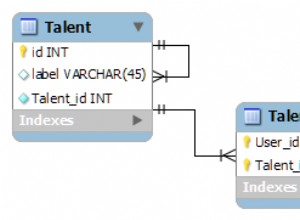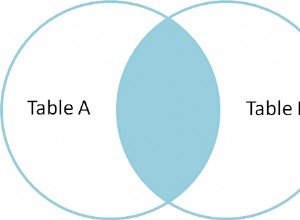Sembri essere un po' caotico nella descrizione del problema, per favore formatta la tua domanda e rendila più leggibile. Comunque le soluzioni sono semplici. Hai solo bisogno di un if istruzione, dove, a seconda del livello, si cerca nella prima o nella seconda tabella e nella colonna corretta:
create or replace function get_accountdetails (par_input in varchar2) return varchar2 is
v_aid varchar2(10);
v_db varchar2(10);
v_lvl varchar2(10);
v_ret varchar2(20) := '';
begin
v_aid := regexp_substr(par_input, '\d+', 1, 1);
v_db := regexp_substr(par_input, '\d+', 1, 2);
v_lvl := regexp_substr(par_input, '\d+', 1, 3);
if v_lvl = 1 then
select dim_cust_key
into v_ret
from dim_cust_acnt
where level1_account_id = v_aid and database_id = v_db;
elsif v_lvl = 2 then
select dim_cust_key
into v_ret
from dim_cust_dept
where level2_account_id = v_aid and database_id = v_db;
else
select dim_cust_key
into v_ret
from dim_cust_dept
where level3_account_id = v_aid and database_id = v_db;
end if;
return v_ret;
end;
Ecco le tabelle e le chiamate di funzione di esempio:
create table dim_cust_acnt (dim_cust_key, level1_account_id, database_id) as (
select 1123, 112, 22 from dual union all
select 1234, 113, 23 from dual );
create table dim_cust_dept (dim_cust_key, level2_account_id, level3_account_id, database_id) as (
select 1587, 245, 301, 21 from dual union all
select 1576, 289, 304, 20 from dual);
select get_accountdetails('[112].[22].[1]') from dual; -- result: 1123
select get_accountdetails('[289].[20].[2]') from dual; -- result: 1576
select get_accountdetails('[301].[21].[3]') from dual; -- result: 1587
Utilizza i nomi delle colonne corretti che hai nei tuoi dati reali e regola i tipi e la lunghezza delle variabili se necessario. Penso che potresti anche usare una query unita, nessuna funzione speciale necessaria, qualcosa come di seguito. Ho usato full join , perché i tuoi esempi non contengono righe corrispondenti. Probabilmente semplice join sarà sufficiente.
with t(par_input) as (select '[112].[22].[1]' from dual)
select dim_cust_key
from dim_cust_acnt a
full join dim_cust_dept d using (dim_cust_key)
cross join t
where ( 1 = regexp_substr(par_input, '\d+', 1, 3)
and regexp_substr(par_input, '\d+', 1, 1) = level1_account_id
and regexp_substr(par_input, '\d+', 1, 2) = a.database_id )
or ( 2 = regexp_substr(par_input, '\d+', 1, 3)
and regexp_substr(par_input, '\d+', 1, 1) = level2_account_id
and regexp_substr(par_input, '\d+', 1, 2) = d.database_id )
or ( 3 = regexp_substr(par_input, '\d+', 1, 3)
and regexp_substr(par_input, '\d+', 1, 1) = level3_account_id
and regexp_substr(par_input, '\d+', 1, 2) = d.database_id )
Risultato:
DIM_CUST_KEY
------------
1123
Se rimuovi with e cross join parti e aggiungi into clausola allora puoi usare questa query in funzione invece di if dichiarazione.
Modifica:
Scusa per il ritardo, ultimamente non ho guardato Stack Overflow. Ecco due esempi su come scrivere le tue funzioni:
Questa funzione restituisce una stringa concatenata:
select get_details_1('[112].[22].[1],[289].[20].[2],[301].[21].[3]') as list from dual;
LIST
------------------
1123,1576,1587
E la seconda funzione è pipeline e restituisce i dati come raccolta predefinita di stringhe, quindi i valori sono in righe separate.
select column_value
from table(get_details_2('[112].[22].[1],[289].[20].[2],[301].[21].[3]'));
COLUMN_VALUE
------------
1123
1576
1587
Puoi anche analizzare inizialmente tutti i dati di input, archiviarli in una raccolta e quindi utilizzare la raccolta in blocco in una query. Ci sono molte soluzioni e possibilità, personalmente userei la funzione pipeline, ma dipende dalla forma di output di cui hai bisogno (raccolta o stringa concatenata). Inoltre puoi aggiungere begin ... end blocca e gestisci l'eccezione when no_data_found . È quindi possibile presentare informazioni speciali o interrompere l'esecuzione, dipende dal comportamento previsto in tale situazione.
Funzione 1:
create or replace function get_details_1 (par_input in varchar2) return varchar2 is
v_aid varchar2(10);
v_db varchar2(10);
v_lvl varchar2(10);
v_ret varchar2(20);
v_all varchar2(200) := '';
i_cnt int := 0;
begin
loop
v_aid := regexp_substr(par_input, '\d+', 1, i_cnt + 1);
v_db := regexp_substr(par_input, '\d+', 1, i_cnt + 2);
v_lvl := regexp_substr(par_input, '\d+', 1, i_cnt + 3);
i_cnt := i_cnt + 3;
exit when v_aid is null;
select dim_cust_key
into v_ret
from dim_cust_acnt a
full join dim_cust_dept d using (dim_cust_key)
where (v_lvl = 1 and level1_account_id = v_aid and a.database_id = v_db)
or (v_lvl = 2 and level2_account_id = v_aid and d.database_id = v_db)
or (v_lvl = 3 and level3_account_id = v_aid and d.database_id = v_db);
v_all := v_all||','||v_ret;
end loop;
return ltrim(v_all, ',');
end;
Funzione 2:
create or replace function get_details_2 (par_input in varchar2)
return sys.odcinumberlist pipelined is
v_aid varchar2(10);
v_db varchar2(10);
v_lvl varchar2(10);
v_ret varchar2(20);
i_cnt int := 0;
begin
loop
v_aid := regexp_substr(par_input, '\d+', 1, i_cnt + 1);
v_db := regexp_substr(par_input, '\d+', 1, i_cnt + 2);
v_lvl := regexp_substr(par_input, '\d+', 1, i_cnt + 3);
i_cnt := i_cnt + 3;
exit when v_aid is null;
select dim_cust_key
into v_ret
from dim_cust_acnt a
full join dim_cust_dept d using (dim_cust_key)
where (v_lvl = 1 and level1_account_id = v_aid and a.database_id = v_db)
or (v_lvl = 2 and level2_account_id = v_aid and d.database_id = v_db)
or (v_lvl = 3 and level3_account_id = v_aid and d.database_id = v_db);
pipe row (v_ret);
end loop;
return;
end;




